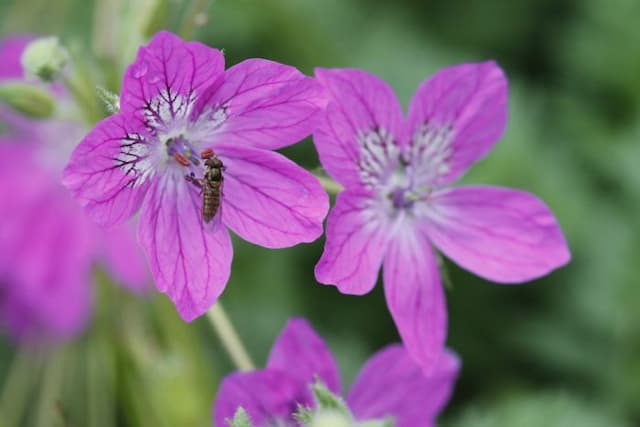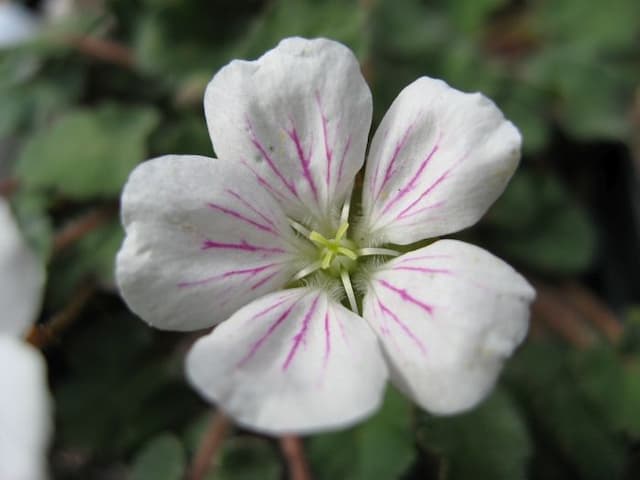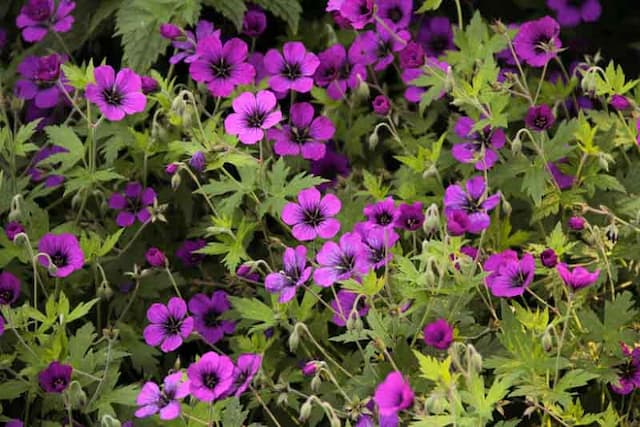Cranesbill Geranium 'Khan'

ABOUT
The Geranium 'Khan' is a perennial plant with a bushy appearance boasting dense foliage. The leaves of this Geranium are notably attractive, typically bearing a deep green color and have a unique shaped with a rounded form, often slightly lobed or deeply cut, which gives them a lacy appearance. The velvety texture of the leaves is also noteworthy, adding to the tactile experience of the plant. Come blooming season, the Geranium 'Khan' produces flowers that are truly a sight to behold. The blossoms are characterized by their striking color, which can range from shades of vibrant purple to blue with contributions of red or pink, sometimes with distinctive veining or eye-catching color patterns that create a stunning contrast against the green foliage. Each flower is composed of five rounded petals that are held aloft on slender stems, giving the plant a delicate and airy look. The arrangement of the flowers is often in clusters, giving a fuller and more abundant impression, which enhances the ornamental appeal of the Geranium 'Khan'. As the plant continues to bloom, the floral display becomes more profuse, covering the plant with a tapestry of color that can last for a good portion of the growing season, offering a long-lasting visual interest. Overall, the Geranium 'Khan' has a charming and robust presence in the garden with its lush foliage and generous blooms that can add both texture and color to any planting scheme. It is valued for its easy-going nature, making it a favorite among gardeners who wish to bring long-lasting and striking beauty to their outdoor spaces without worrying about extensive maintenance.
About this plant
 Names
NamesFamily
Geraniaceae.
Synonyms
Crane's-Bill, Hardy Geranium, Garden Geranium.
Common names
Geranium 'Khan'
 Toxicity
ToxicityTo humans
Geraniums, including the 'Khan' variety, are not considered highly toxic to humans. However, ingestion of large amounts of the plant can potentially cause mild upset stomach, diarrhea, vomiting, and a rash if there is contact with sensitive skin. It is generally recommended to avoid eating geraniums, and to keep them out of the reach of children who might be tempted to chew on the leaves or flowers.
To pets
Geraniums are known to be toxic to pets, particularly dogs and cats. If a pet ingests part of a geranium, they may experience symptoms such as vomiting, anorexia, depression, and dermatitis. In more severe cases, ingestion can lead to more serious side effects such as lethargy, loss of appetite, and skin irritation. If you suspect your pet has ingested geraniums, it is best to consult a veterinarian as soon as possible.
 Characteristics
CharacteristicsLife cycle
Perennials
Foliage type
Deciduous
Color of leaves
Varies
Flower color
Mixed
Height
1-2 feet (30-60 cm)
Spread
1-2 feet (30-60 cm)
Plant type
Herb
Hardiness zones
5
Native area
Middle East
Benefits
 General Benefits
General Benefits- Aesthetic Appeal: Adds vibrant color and visual interest to gardens with its magenta-pink flowers.
- Attracts Pollinators: Bees and butterflies are drawn to its nectar-rich blooms, aiding in pollination.
- Drought Tolerance: Once established, it is quite drought-resistant, requiring minimal watering.
- Easy Maintenance: Known for being low-maintenance, only needing basic care to thrive.
- Long Blooming: Produces flowers from mid-spring to early fall, offering prolonged beauty.
- Adaptability: Can be grown in various soil types, as long as there is good drainage.
- Container Gardening: Well-suited for pots and containers, perfect for patios and balconies.
- Garden Borders: Ideal for use in borders due to its compact growth habit and continuous blooms.
 Medical Properties
Medical PropertiesThis plant is not used for medical purposes.
 Air-purifying Qualities
Air-purifying QualitiesThis plant is not specifically known for air purifying qualities.
 Other Uses
Other Uses- Ink Production: Extracts from Geranium 'Khan' petals can be used to create natural dyes for eco-friendly ink formulations.
- Fabric Dye: The plant's vivid colors lend themselves to the natural dyeing of textiles, giving fabrics a unique hue without synthetic chemicals.
- Photography: Geranium 'Khan' flowers can be used in the art of flower photography, adding aesthetic value and a splash of color to various compositions.
- Garden Design: Used as a ground cover, Geranium 'Khan' can provide visual continuity in landscape design, leading the eye through garden spaces.
- Botanical Illustration: Artists can use Geranium 'Khan' as a subject for botanical illustration, capturing its form and color in detailed artwork.
- Companion Planting: When planted alongside vegetables like tomatoes, Geranium 'Khan' can help deter certain pests with its strong scent.
- Culinary Garnish: Petals from the Geranium 'Khan' may serve as an ornate and edible garnish on fine dishes for an added touch of elegance.
- Aromatherapy: The essential oils extracted from Geranium 'Khan' can be used in aromatherapy for their fragrance to help reduce stress.
- Floral Arrangements: Its attractive blooms are ideal for cutting gardens and make for a long-lasting addition to floral arrangements and bouquets.
- Creative Crafts: Dried Geranium 'Khan' flowers can be incorporated into homemade paper, potpourri, or other craft projects for added texture and color.
Interesting Facts
 Feng Shui
Feng ShuiThe plant Geranium is not used in Feng Shui practice.
 Zodiac Sign Compitability
Zodiac Sign CompitabilityThe plant Geranium is not used in astrology practice.
 Plant Symbolism
Plant Symbolism- Protection: Geraniums are often associated with warding off negative energies, which is why they are frequently planted in gardens and used in homes to provide a protective shield.
- Friendship: Sharing geraniums is thought to be a way of extending friendship or a hand of kindness, making them a popular gift among friends.
- Health: With their sweet, fresh scent, geraniums are believed to promote emotional balance and well-being, symbolizing good health and the restoration of the body.
- Fertility: In some cultures, geraniums signify fertility and new growth, making them a fitting decoration in matrimonial settings or celebrations of new beginnings.
- Good Luck: Carrying a geranium leaf or flower is said to attract good fortune, hence people sometimes include them in bouquets or wear them for luck.
- Peace: The presence of geraniums is used to encourage a peaceful and calming atmosphere, as the plant is associated with tranquility.
 Water
WaterCranesbill Geranium should be watered deeply once a week, allowing the soil to dry out between waterings. When you do water, aim for about one gallon per square yard of soil. This ensures the roots are adequately hydrated without being waterlogged. During hot spells or in particularly dry climates, you might need to water twice a week. Make sure to avoid overhead watering to reduce the risk of leaf diseases; instead, water at the base of the plant.
 Light
LightCranesbill Geranium thrives in full sun to partial shade. It is best positioned in a spot that receives at least 4 to 6 hours of sunlight per day. However, in very hot climates, afternoon shade is beneficial to prevent scorching. The ideal location is somewhere with morning sun and dappled afternoon shade to maintain vibrant blooms and healthy foliage.
 Temperature
TemperatureCranesbill Geraniums prefer temperatures between 60 and 75 degrees Fahrenheit but can survive in temperatures as low as 55 degrees Fahrenheit and as high as 80 degrees Fahrenheit. They should be protected from frost and extreme heat, as prolonged exposure to temperatures outside their comfort range can be detrimental to their health.
 Pruning
PruningPrune Cranesbill Geranium to encourage bushier growth and to remove spent flowers, which promotes further blooming. Light pruning can be done throughout the growing season as necessary. The best time for a more thorough pruning is in early spring or just after the first bloom to rejuvenate the plant and maintain its shape.
 Cleaning
CleaningAs needed
 Soil
SoilThe Geranium 'Khan', often known as Cranesbill, thrives in well-draining soil that is rich in organic matter with a pH of 5.8 to 6.3. A good soil mix for Cranesbill can be composed of equal parts garden soil, peat moss, and perlite or coarse sand to improve drainage.
 Repotting
RepottingCranesbill (Geranium 'Khan') should be repotted every 1 to 2 years, or when it becomes root-bound and the soil is exhausted. Early spring is typically the best time for repotting.
 Humidity & Misting
Humidity & MistingCranesbill, or Geranium 'Khan', prefers moderate humidity levels but is quite adaptable and can tolerate the dry air typically found indoors in homes.
 Suitable locations
Suitable locationsIndoor
Place in bright, indirect light, and allow soil to dry between waterings.
Outdoor
Plant in part sun to shade; water regularly but don't overwater.
Hardiness zone
4-8 USDA
 Life cycle
Life cycleGeranium 'Khan', commonly known as Crane's-bill, starts its life cycle as a seed, which, when sown in early spring, germinates in warm, moist soil. Once the seedling emerges, it develops true leaves and begins the vegetative stage, focusing on the growth of foliage and roots to establish the plant. As it matures, Geranium 'Khan' enters the flowering stage, usually in late spring to early summer, producing distinctive flowers that attract pollinators. After pollination, the plant sets seed within the characteristic beak-like fruit that inspired the common name. The plant enters a period of dormancy during the colder months, conserving energy and resources. In subsequent growing seasons, the perennial Geranium 'Khan' resumes vegetative growth, followed by flowering and seed set, continuing its life cycle for several years.
 Propogation
PropogationPropogation time
Spring-Early Summer
Propogation: The Geranium 'Khan', commonly known as the Khan Cranesbill, is best propagated during the spring or early summer when the plant is actively growing. The most popular method is through stem cuttings. Start by selecting a healthy stem that is about 4 to 6 inches (10 to 15 cm) long with several leaves. Using a sharp, clean knife or scissors, cut just below a leaf node where the concentration of natural rooting hormones is high. Remove the leaves from the lower half of the cutting to prevent decay. Dip the cut end into rooting hormone powder to encourage root development and plant the cutting in a pot filled with a mixture of peat and perlite or a similar well-draining potting mix. Keep the soil moist but not waterlogged and place the pot in a warm, well-lit area without direct sunlight. In a few weeks, when the cutting has rooted, it can be transplanted to a larger pot or directly into the garden.









![Cranesbill [Rothbury Gem]](/_next/image?url=https%3A%2F%2Fplants-admin.emdemapps.com%2Fimages%2Fplants%2F%2Fimages%2F604b6243984c2.png&w=640&q=75)